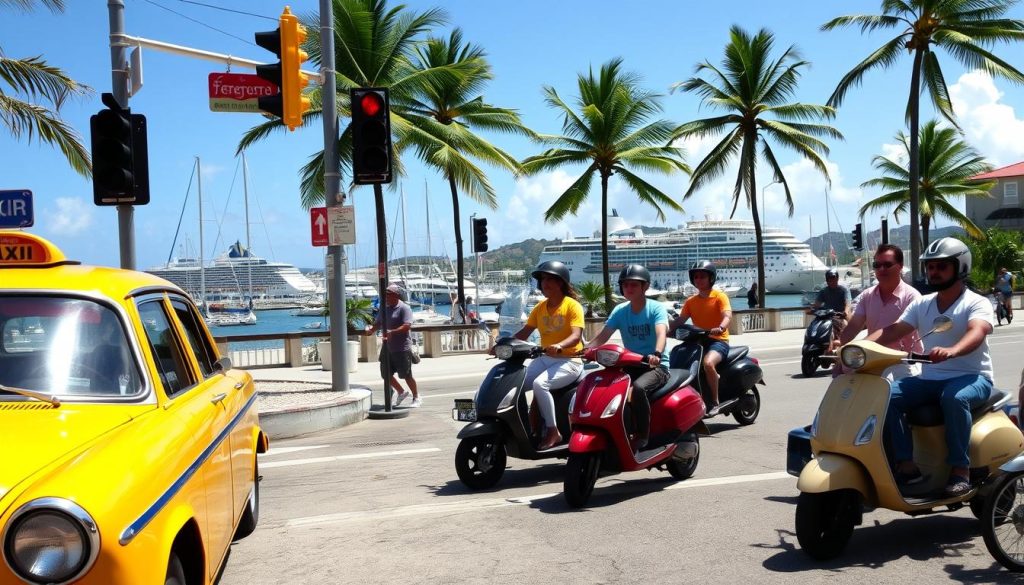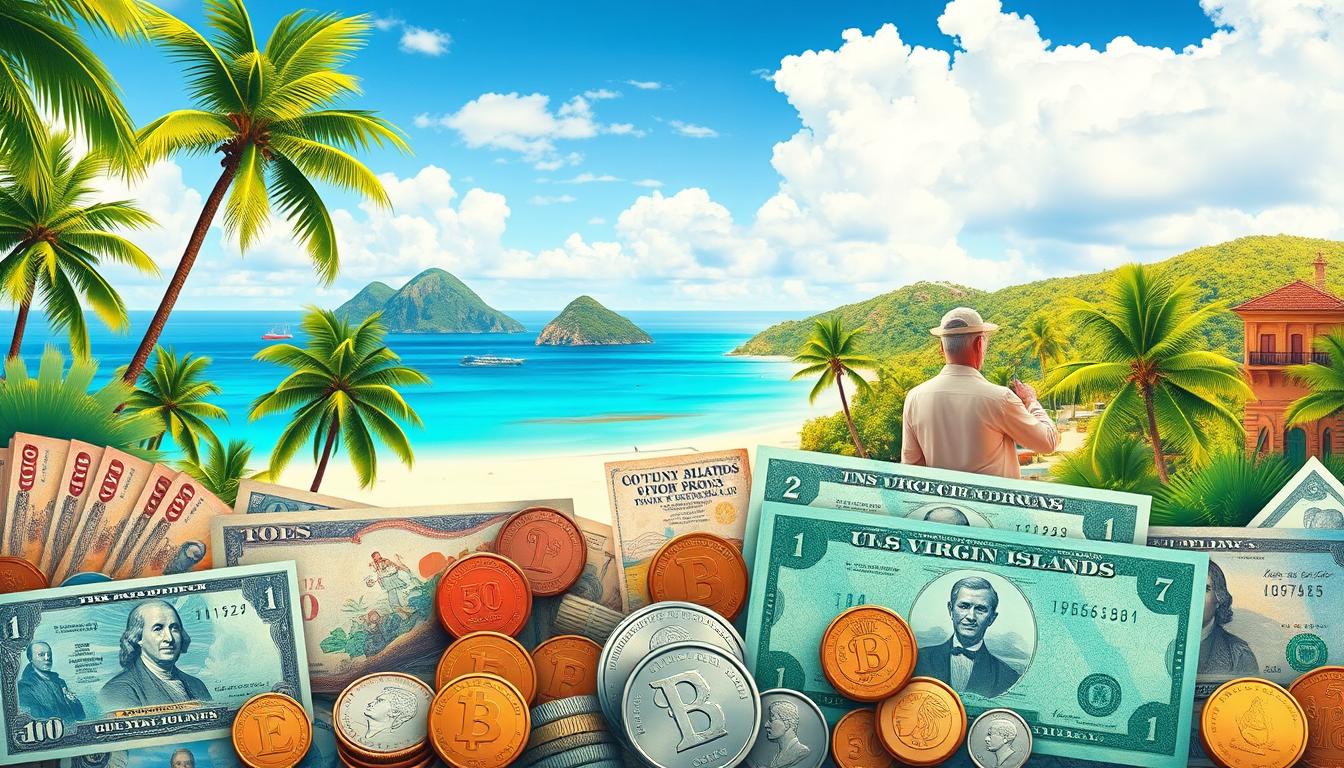✓ Accommodations✓ Flights✓ Rental Cars✓ Tours & Activities
Did you know that the U.S. dollar is the official currency in this tropical paradise? That’s right—no need to worry about exchange rates or foreign transaction fees. For U.S. citizens, traveling here feels just like a domestic trip, with no passport required. It’s one of the many perks that make these islands a hassle-free destination.
The islands are a blend of vibrant culture and breathtaking scenery. From pristine beaches to lush trails, there’s something for everyone. Whether you’re planning a relaxing getaway or an adventurous escape, this guide will help you prepare financially and navigate your trip with ease.
You’ll learn about managing money on the go, using your credit card, and tips for local transport. With friendly advice and practical insights, this guide ensures your journey is as smooth as the island breeze. Let’s dive in and make your travel planning effortless!
Discovering the Allure of the U.S. Virgin Islands
Escape to a Caribbean paradise where culture meets stunning landscapes. The U.S. Virgin Islands are a dream destination for those seeking sun, sand, and vibrant experiences. With its warm climate and friendly locals, this tropical haven promises an unforgettable getaway.

A Tropical Haven for Your Caribbean Getaway
For U.S. citizens, traveling here is hassle-free. No passport is required, and the U.S. dollar is the official currency. This makes it an ideal spot for a quick escape or a longer vacation. Duty-free shopping adds to the appeal, offering great deals on luxury items and local crafts.
The islands are known for their pristine beaches and lush trails. Whether you’re relaxing by the water or exploring hidden gems, there’s something for everyone. The vibrant culture and rich history make every moment here unique.
Exploring the Unique Differences: USVI vs. BVI
While both the U.S. Virgin Islands and the British Virgin Islands share stunning scenery, they offer distinct experiences. The U.S. Virgin Islands are easier to access for U.S. travelers, with no passport needed. The British Virgin Islands, on the other hand, require one and have a more secluded vibe.
Ferries connect the islands, making it easy to explore multiple destinations. Each city and area has its own charm, from bustling markets to quiet coves. Spend your time discovering the unique highlights of each island, from historical sites to breathtaking views.
U.S. Virgin Islands: Ultimate Travelers Guide to Currencies & Payments
Planning your trip to this tropical destination? Managing your money is easier than you think. The U.S. dollar is the official currency here, making it a seamless experience for travelers from the United States. No need to worry about exchange rates or foreign transaction fees—everything is straightforward and hassle-free.
Navigating the U.S. Dollar Advantage
One of the biggest perks of visiting this island paradise is the use of the U.S. dollar. This eliminates the need for currency exchange, saving you time and money. Whether you’re dining at a local restaurant or shopping for souvenirs, you’ll find that prices are clear and transactions are smooth.
ATMs are widely available across the islands, making it easy to withdraw cash when needed. Most establishments also accept credit cards, so you can leave your wallet light and still enjoy your trip. Just be aware of any potential fees from your bank for international transactions.
Essential Payment Methods and Credit Options
When it comes to payments, you have plenty of options. Credit and debit cards are accepted at most hotels, restaurants, and shops. Mobile payment services are also becoming more common, offering a convenient way to make purchases without carrying cash.
Here are some tips to keep in mind:
- Check with your bank about foreign transaction fees before your trip.
- Notify your card issuer of your travel plans to avoid any issues with your credit card.
- Carry some cash for smaller purchases or in case of power outages that might affect card service.
By following these simple steps, you can ensure a stress-free financial experience during your stay.
Pre-Trip Financial Preparation and Currency Exchange
Proper financial planning ensures a stress-free island adventure. By organizing your budget and documents ahead of time, you can focus on enjoying your trip without worrying about unexpected expenses.

Securing the Best Exchange Rates Before You Go
One of the first steps in pre-trip planning is securing the best exchange rates. Avoid inflated rates at the airport by comparing options at banks, credit unions, or reputable online platforms. Timing is key—exchange your currency when rates are favorable to save money.
Here’s a quick comparison of exchange options:
| Option | Pros | Cons |
|---|---|---|
| Banks | Competitive rates, secure | May require advance notice |
| Credit Unions | Lower fees, member benefits | Limited availability |
| Online Platforms | Convenient, often better rates | Delivery fees may apply |
Setting Up Your Travel Budget and Documents
Creating a travel budget helps you manage expenses like flights, rentals, and activities. Include a buffer for unforeseen costs to avoid overspending. While U.S. citizens don’t need a passport for this destination, carrying a valid ID is always a good idea.
Here are some tips for budgeting:
- Compare prices for flights and accommodations to find the best deals.
- Allocate funds for meals, transportation, and souvenirs.
- Set aside emergency cash for unexpected situations.
By planning ahead, you can make the most of your time and enjoy a worry-free trip.
Managing Money on the Ground in the USVI
Handling your finances during your stay is simple and stress-free. The U.S. dollar is the official currency, so you won’t need to worry about exchange rates or conversion fees. This makes it easy to focus on enjoying your time on the island without financial hassles.

Using ATMs, Credit Cards, and Mobile Payments
ATMs are widely available across the island, making it easy to withdraw cash whenever needed. Most establishments, including restaurants and shops, accept credit cards and mobile payments. This ensures you can make purchases quickly and securely.
Here are some tips to keep in mind:
- Use ATMs in well-lit, secure locations to protect your funds.
- Notify your bank of your travel plans to avoid issues with your card.
- Carry some cash for smaller purchases or places that don’t accept cards.
Mobile payment options are also growing in popularity. Services like Apple Pay and Google Wallet offer a convenient way to pay without carrying cash. This is especially useful when you’re out exploring the island or relaxing by the water.
By following these simple steps, you can ensure a smooth and secure financial experience during your stay. Enjoy your trip without worrying about money!
Navigating Local Transportation and Tipping Etiquette
Getting around the islands is easy and convenient with a variety of transportation options. Whether you prefer the flexibility of a car rental or the ease of a taxi, you’ll find a way to explore that suits your style. Understanding local customs, like tipping and driving on the left side of the road, will make your journey smoother.

Taxi, Car Rental, and Alternative Travel Options
Taxis are a popular choice for short trips. They often charge per person, so it’s a good idea to confirm the fare before starting your ride. For more flexibility, consider renting a car. Remember, vehicles drive on the left side of the road, which might take some getting used to if you’re not familiar with it.
Here’s a quick comparison of transportation options:
| Option | Pros | Cons |
|---|---|---|
| Taxi | Convenient, no need to navigate | Can be expensive for long distances |
| Car Rental | Flexibility, explore at your own pace | Driving on the left side may be challenging |
| Shuttle | Affordable, good for groups | Limited schedules and routes |
For those who prefer not to drive, shuttles and ferries are great alternatives. Ferries connect the islands, offering a scenic way to travel between destinations.
Understanding Tipping Customs and Additional Fees
Tipping is a common practice here. In restaurants, a tip of 15-20% is standard. For taxi drivers, rounding up the fare or adding a small amount is appreciated. Keep in mind that some services may include additional fees, so it’s always a good idea to ask beforehand.
Here are some tips for tipping and handling fees:
- Carry small bills for easier tipping.
- Check if a service charge is already included in your bill.
- Be prepared for potential fees like baggage handling or parking.
Using your phone to navigate transportation apps can also be helpful. Many apps provide real-time updates and contact information for local drivers, making it easier to plan your way around the islands.
By understanding these transportation and tipping customs, you can enjoy a hassle-free experience while exploring all the islands have to offer.
Exploring Cultural Experiences and Leisure Activities
Immerse yourself in a world of cultural richness and leisure activities on these stunning islands. From pristine beaches to vibrant local festivals, there’s something for everyone to enjoy. Whether you’re a history buff, a foodie, or an adventurer, this destination offers endless opportunities to explore and relax.
Beaches, Historical Tours, and Local Dining
The islands are home to some of the most beautiful beaches in the world. Spend your day soaking up the sun or snorkeling in crystal-clear waters. For history enthusiasts, guided tours of colonial landmarks and museums provide a glimpse into the islands’ past.
Local restaurants offer a fusion of Caribbean and international flavors. From fresh seafood to tropical fruits, every meal is a culinary adventure. Don’t miss the chance to try traditional dishes like conch fritters or johnnycakes.
Walking Tours and Shopping Adventures
Explore the city streets on a walking tour to discover hidden gems and vibrant murals. These tours often include stops at local markets, where you can shop for handmade crafts and souvenirs. Duty-free shopping is another highlight, offering great deals on luxury items.
Seasonal Events and Local Festivals
Throughout the year, the islands host a variety of cultural events and festivals. Carnival celebrations in April and the St. John Festival in June are must-see events. These festivals feature music, dance, and local cuisine, celebrating the islands’ rich heritage.
Here’s a quick guide to seasonal events:
| Event | Season | Highlights |
|---|---|---|
| Carnival | April | Parades, music, and traditional costumes |
| St. John Festival | June | Cultural performances and local food |
| Emancipation Day | July | Historical reenactments and fireworks |
By participating in these activities, you’ll gain a deeper appreciation for the islands’ culture and history. Whether you’re relaxing on the beach or exploring a historic site, every moment here is unforgettable.
Conclusion
Planning a trip to this tropical paradise? Here’s how to make it seamless and stress-free. Start with pre-trip preparations like budgeting and checking exchange rates. Once you arrive, managing money is easy with the U.S. dollar and widespread credit card acceptance.
Transportation is straightforward. Taxis are convenient, and renting a car lets you explore at your own pace. Remember to drive on the left side of the road. Tipping is customary, so carry small bills for services like dining and rides.
Enjoy your time here by balancing leisure and cultural activities. From pristine waters to vibrant city tours, there’s something for everyone. With these tips, you’re ready to make the most of your destination.
Feel confident navigating the unique financial landscape of the island. Your adventure awaits—plan wisely and enjoy every moment!
The above is subject to change.
Check back often to TRAVEL.COM for the latest travel tips and deals.






